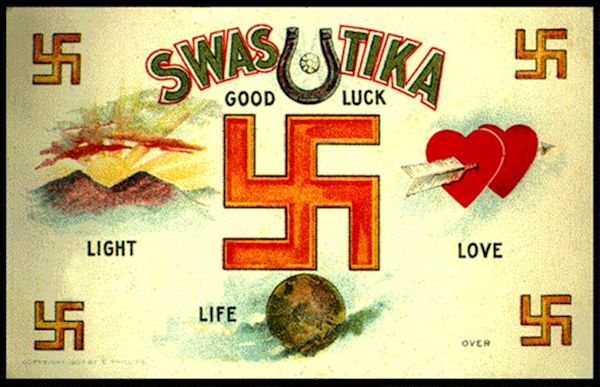
![]()

|
|

![]()

Non-German Swastikas

|
|
|
|
Here is the most strange swastika-bedecked “thing” we have ever seen. Origin??? It's actually for sale for $150 by a consigner who also does not know anything about it except it certainly does show a lot of intensive work. We have no idea what it is, either. |
|
|
|||||||||||||||||||||||||
|
School Chart Chronicling the History of the Swastika, Das Hakenkreuz als sonnbild in der Geschichte |
|||||||||||||||||||||||||
| DESCRIPTION: This is a pictorial chart that illustrates the use of the swastika down through the ages in the history of Aryan people. The chart was probably put together in the mid 1920s, when Adolf Hitler first started showing the symbol in the Nazi flags and ceremonial displays. So constant was the exhibition of this hooked cross, that the educational system felt compelled to instruct the youngsters about its origins. Of course, the same chart was no doubt used right into the 1930s and 1940s, as well. The chart was a marvelous teaching aid for the students, and it was produced by a Dresden firm. The chart measures 39 x 28 inches and is produced in a fine heavy oilcloth (not paper). When opened it’s supported with two wooden shafts that hold it in position. Below all the pictures numbers can be seen that correspond to the pictures with explanations after each one. There are 44 pictures and an equal amount of the explanations. The chart is very colorful, and the educational value is practically sacrosanct, even today. Items shown with the swastika include pottery, jewelry, coins, lances, swords, and decorative architectural embellishments from ancient Roman and Germanic sources. It is very interesting to observe the varieties and shapes of the swastikas through the centuries. There were curved, mobile, stationary, and short-armed swastikas. Some were formed by horses heads, human legs, and vegetation motifs used by the ancients. This was practically a universal design, but in this case only the Germanic and Teutonic usage is explored. The chart is in perfect condition and is a very rare museum offering.
PRICE: $985.00 |